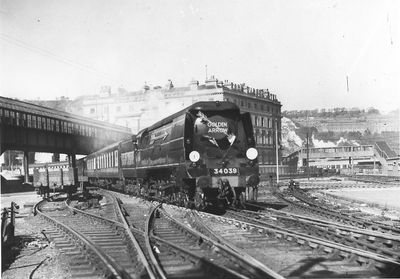Boscastle Locomotive Limited
The 'West Country' class -
a Brief History
In 1941 the Southern Railway introduced the 'Merchant Navy' class locomotives, designed by their Chief Mechanical Engineer O.V.S. Bulleid.
The design featured many innovative features such as, an 'air-smoothed' casing over the upper half of the locomotive, chain driven valve gear in an enclosed oil bath, a steel inner firebox and electric lighting.
To enable the locomotives to be built under wartime restrictions they were classed as 'mixed traffic' - able to be used on both freight and passenger work, but are generally regarded as express passenger locomotives.
Although the 'Merchant Navys' proved more than capable of performing the tasks asked of them, their size and weight prevented them from working on many of the secondary lines on the system. To fill this gap, a light weight version of the 'Merchant Navy' was conceived.
The first of the new 'West Country' class was completed in May 1945, as it was envisaged that the locomotives would work predominantly in the south west, they were named after west country towns and villages. and production continued from then on, both by the Southern Railway and after nationalisation in 1948, by British Railways. In 1947 with increasing numbers of the design, the decision was taken to give some of the new locomotives names associated with the battle of Britain. Although of the same design, the 44 locomotives so treated, are generally referred to as 'Battle of Britains'. A total of 110 locomotives were built with the final locomotive being turned out of Brighton works in January 1951.
Their lower weight enabled them to go almost anywhere on the Southern system while their relatively high power enabled them to perform as well as the 'Merchant Navys' on all but the heaviest of trains. By the mid 1950s, the more unconventional features of the design, exacerbated by labour shortages, made the locomotives difficult to maintain and expensive to run.
In 1955 the decision was taken to rebuild both the 'Merchant Navy' and the 'West Country' classes to remove the more troublesome design features. whilst retaining as much of the original as possible to minimise cost. The first 'Rebuilt West Country' was completed at Eastleigh works in June 1957.
There has been much debate as to whether the rebuilding constituted an improvement. For the fitters charged with maintaining the locomotives there were undoubted advantages, in particular the improved accessibility and removal of the troublesome oilbath.
For the footplate crews, preparation took longer and involved more work underneath the locomotives but they became more predictable and reliable machines to operate.
It is probably fair to say that the rebuilds were better suited to the difficult post-war conditions and availability for traffic was much improved as a result of the modifications.
During the early 1960s, the Modernisation Plan for British Railways was slowly but surely coming to fruition and the end of steam was inevitable. The rebuilding programme was brought to a halt in 1961 with 34104 'Bere Alston' being the 60th and last 'West Country' to be rebuilt, the remaining locomotives continued in service in their original form.
Withdrawals of the class started in 1963 with the final locomotives being withdrawn in July 1967 at the end of steam on the Southern Region

